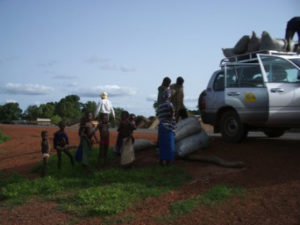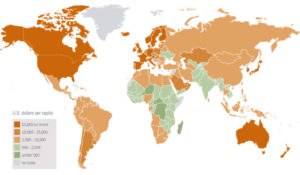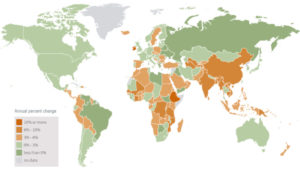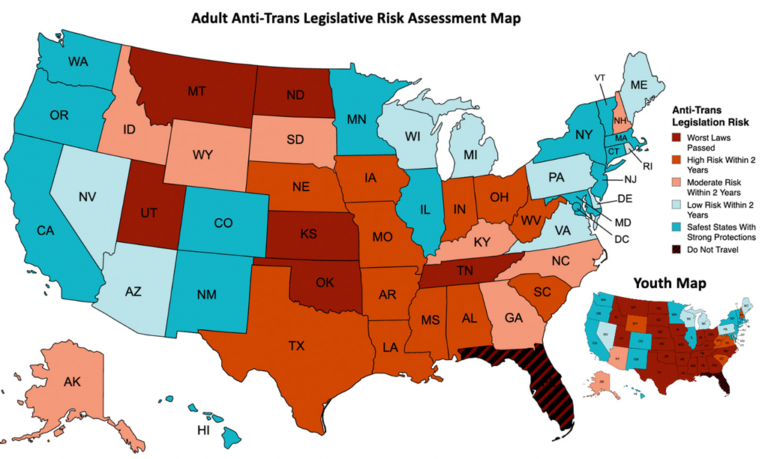Geography, Institutions and the Fate of People and Planet in the 21st Century
 Let’s talks about Geographical Determinism. Got your attention? I thought so. The term, along with its cousin, Environmental Determinism, has long been disdained and pejorative amongst geographers, anthropologists and other disciplines. There is a rightful rejection of determinism’s racist connotations and applications in the 19th and early 20th centuries. There is also good cause to question explanations of complex societal attributes and histories that are based on selected geographic/environmental conditions alone. To even utter the terms Geographical Determinism here in the Newsletter of the American Association of Geographers, much less start a column this way, might well be considered a step into dangerous waters!
Let’s talks about Geographical Determinism. Got your attention? I thought so. The term, along with its cousin, Environmental Determinism, has long been disdained and pejorative amongst geographers, anthropologists and other disciplines. There is a rightful rejection of determinism’s racist connotations and applications in the 19th and early 20th centuries. There is also good cause to question explanations of complex societal attributes and histories that are based on selected geographic/environmental conditions alone. To even utter the terms Geographical Determinism here in the Newsletter of the American Association of Geographers, much less start a column this way, might well be considered a step into dangerous waters!

My reasons are not, however, to delve into the darker corners of our discipline’s history or weigh the value of examining humankind’s past through an environmental lens. Rather my focus is on the present-day and the future. My purpose being to examine some current academic and policy debates that could shape the fates of people and the planet over the 21st century. These are debates that geographers should be front and center in, because they are explicitly concerned with the role of geography in determining that future.
To illustrate the currency of this topic let’s consider the depressingly low per-capita gross domestic product of much of sub-Saharan Africa. This past month there was an interesting article in Business Daily entitled How economic geography has conspired to keep Africa down. By the term “economic geography” the article was not referring to the sub-discipline of economic geography or its academic practitioners, but rather the economic argument that “the underdevelopment of the continent is a case of “bad latitude” and that income disparities within and between regions can be explained by erratic climate, poor soil, low agricultural productivity and infectious disease.” Might this argument not be called geographic determinism? Let’s look at the context from which this article in Business Daily arose in terms of the current debate over geographical determinism and what is at stake.

Debates about regional differences in economic growth and development have a history as long as economics itself, Adam Smith being one notable proponent of the importance of geography in such variations. Some of the stimulus for the current debate on the economic roles of geography and environment can be traced to 1997 and the impact of Jared Diamond’s book Guns, Germs and Steel along with Jeffrey Sachs’ writings such as Nature, nurture and growth, which appeared in the Economist. Diamond was then a professor in Physiology at UCLA, but would soon join the Department of Geography, and Sachs was director of the Harvard Institute for International Development, and would subsequently become director of The Earth Institute at Columbia. The arguments that Diamond puts forward about geographical configurations and environmental conditions contributing to the economic ascendency of Europe and the West are well known to geographers. It is worth noting however, that Diamond, in contrast to the geographical determinism of the 19th and early 20th century, is explicit that he pursued this work as an argument against racism and racist interpretations of history. In his articles Sachs argues that tropical countries, particularly those with high reliance on the agricultural sector, suffer from economic growth penalties related to geography due to “disease, poor soil, unreliable rainfall, pests, and other tropical ills.” Sachs pays particular attention to the high human and economic costs of tropical diseases. Sachs’ 2006 book; The End of Poverty provides a strong articulation of his arguments in favor of geography being a key economic determinant. In the 1997 Economist article he concludes that geographical conditions may pose “insurmountable barriers to higher incomes” in many tropical regions. In reviewing Guns, Germs and Steel and drawing parallels with Nature, nurture and growth, the Economist headlined their piece with the title “Geographical determinism.” This is the sense in which many people outside geography understand the term today.
Now, criticisms about the role of geography and environment in determining the human condition can be launched from many perspectives. One example of this is the plethora of views expressed on Guns, Germs and Steel in a special section of Antipode published in 2003. However, the questions I am focusing on concern the role of institutions versus geography/environment in determining inequalities in economic development. Institutions in this circumstance could be defined as: The humanly devised constraints that structure social, political and economic exchanges in human societies. Economists might cite things such as property rights and the existence of functional markets as important attributes — although a neoclassical economist would have a very different take on the positive values of these than a Marxist. Perhaps the most well-known proponents of the institutionalist view on regional economic development inequalities are Daron Acemoglu, an economist at MIT, and James Robinson, a political scientist and economist in the Harris School of Public Policy at the University of Chicago. Their views, that institutions trump geography and environment in determining regional economic inequalities, were developed in a number of publications starting with a series of papers in the early 2000s and resulted in the book Why Nations Fail published in 2012. They take direct aim at a number of the geographical arguments posited by Diamond and Sachs. For their empirical arguments they use examples such as the economic underdevelopment of North Korea versus South Korea or the divergence in economic status between European colonies originally dominated by Spain versus those dominated by England. They argue that it is not geography, nor is it culture or race, but economic institutions facilitating stable property rights and robust markets that are the most important determinants of economic prosperity. The responses and counter responses between Diamond, Sachs, Acemoglu and Robinson in the New York Review of Books and in Foreign Affairs illuminate the differences of opinion and arguments related to each side.
Now, given its dark history, many geographers have been reluctant, and even vehemently hostile, to discussing anything that can be remotely considered geographical or environmental determinism. Some of the responses to Guns, Germs and Steel that were published in Antipode provide evidence of this. I suppose that ignoring the debate over geography versus institutions and leaving it to economists and others to argue would be ok if this was merely an academic question. However, that is not the case. For example, Jeffrey Sachs’ 1997 piece in the Economist arose from research he conducted for the Asian Development Bank’s “Emerging Asia” report. The purpose was to forecast and help plan for economic development in Asia. He has been an active policy advisor to governments, including presidents in Africa and Asia and many international organizations. Speaking at a U.N. conference in 2000, U.S. Treasury Secretary Lawrence Summers seemed to echo Sachs when he warned against thinking that “the economic failures of isolated, tropical nations with poor soil, an erratic climate and vulnerability to infectious disease can be traced simply to the failure of governments.” The question of geography versus institutions in terms of economic development is one that transcends the confines of the academy and has real world implications.
People in developing nations, particularly those in the tropics, are facing challenges of providing food, water and economic opportunity for burgeoning populations. In addition, climate change will exacerbate environmental threats from drought, flooding, heatwaves, agricultural pests and human disease in many of these countries. In such a world, we desperately need the right paradigms and strategies for economic development. In this we face two types of error. If we assume that geography and environment are the overwhelming determinants of economic disparity we may well throw resources at infrastructure or other geography/environment focused growth strategies while ignoring socioeconomic issues, which will confound such efforts. On the other hand, to assume that simply providing economic tutelage and some start-up capital here and there will be sufficient in countries which faces real geographic and environmental challenges can be equally ineffective.
What about the planet? It is not just people who pay the price if we cannot get the development balance right. There is a strong correspondence between the locations of the world’s biodiversity hotspots and global poverty. A 2004 paper in Science, led by geographer Bill Adams from Oxford, illustrated the critical linkages between alleviating poverty in the developing world and improving biodiversity conservation there. In Mali, where I have worked, supplying charcoal for domestic use in urban areas such as Bamako leads not only to increased rates of deforestation and associated biodiversity threats, but also contributes to greater greenhouse gas emissions then use of LPG or electricity which are economically unattainable for most people. When economic resources are in short supply, it is difficult to impossible for national environmental conservation efforts to be developed and implemented. At the same time, it does not seem right for international groups to focus funding on endangered species or other environmental concerns alone and ignore the plight of the people in those nations. People and planet must, and can, be considered in unison.
In reading the writings of Diamond, Sachs, Acemoglu, Robinson and others involved in this debate, it is clear that they recognize the balance between the importance of geography versus institutions is not immutable, but can change over space and through time. It seems to me there is much work for geographers from every corner of our discipline to engage with this. Fundamental questions of economic geography, political geography, development geography and political ecology are clearly in play here. Our experience and insights, both in terms of on the ground work and theory, are of obvious value. Geographers such as Michael Watts at Berkeley and Marcus Powers writing articles in the Singapore Journal of Tropical Geography in 2003 and 2009 and Eric Sheppard writing on “Geography, nature, and the question of development” in 2011 in Dialogues in Human Geography are examples of those who have taken up these issues. Indeed, the exciting and developing field of ‘environmental economic geography’ tackles the relationship between environment and economics and the feedback between these realms head on. A 2010 article by Julie Silva, Siri Eriksen, and Zacarias Ombe in the Geographical Journal uses this approach to look at this “double exposure” effects of environment and socioeconomic institutions on farming communities in Mozambique. In addition, the arguments that are posited in some economics articles from both sides of the debate clearly are naive in terms of climate, hydrology, soils, vegetation, crops, etc. There is plenty of scope for work by physical geographers to challenge and refine some of these suppositions.

Where do I stand on all this? I clearly think understanding the relative importance of geography and institutions in determining economic development is a core concern with huge societal and environmental implications. While I take some hope from the fact that in recent years the annual economic growth in sub-Saharan Africa has outstripped the pace in many other parts of the world, I wonder how do we fuel economic growth while also promoting equity in the distribution of these gains and aiding the environment? Geographers cannot shirk from this question. In terms of choosing a side in the debate over geography versus institutions I think I would like to leave the last word to the writer of the Business Daily article, the Kenyan development economist Anzetse Were. As she puts it, “there is an interface between geography and human behaviour. Political instability, the chronic mismanagement of funds by some African governments coupled with Africa’s position in the international division of labour also explain the continent’s limited growth and development, not just its geography. None the less, economic geography provides a perspective of analysis which Kenya could make great use of.” As geographers, let’s help as best we can.
Join the conversation on Twitter #PresidentAAG
—Glen M. MacDonald

